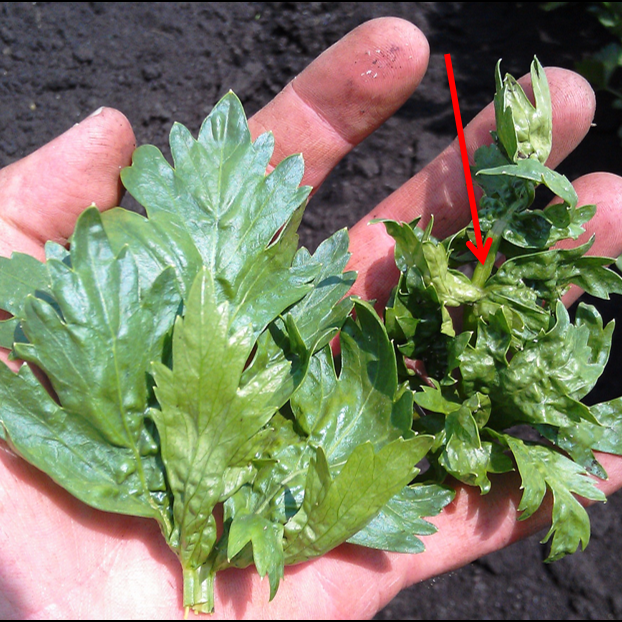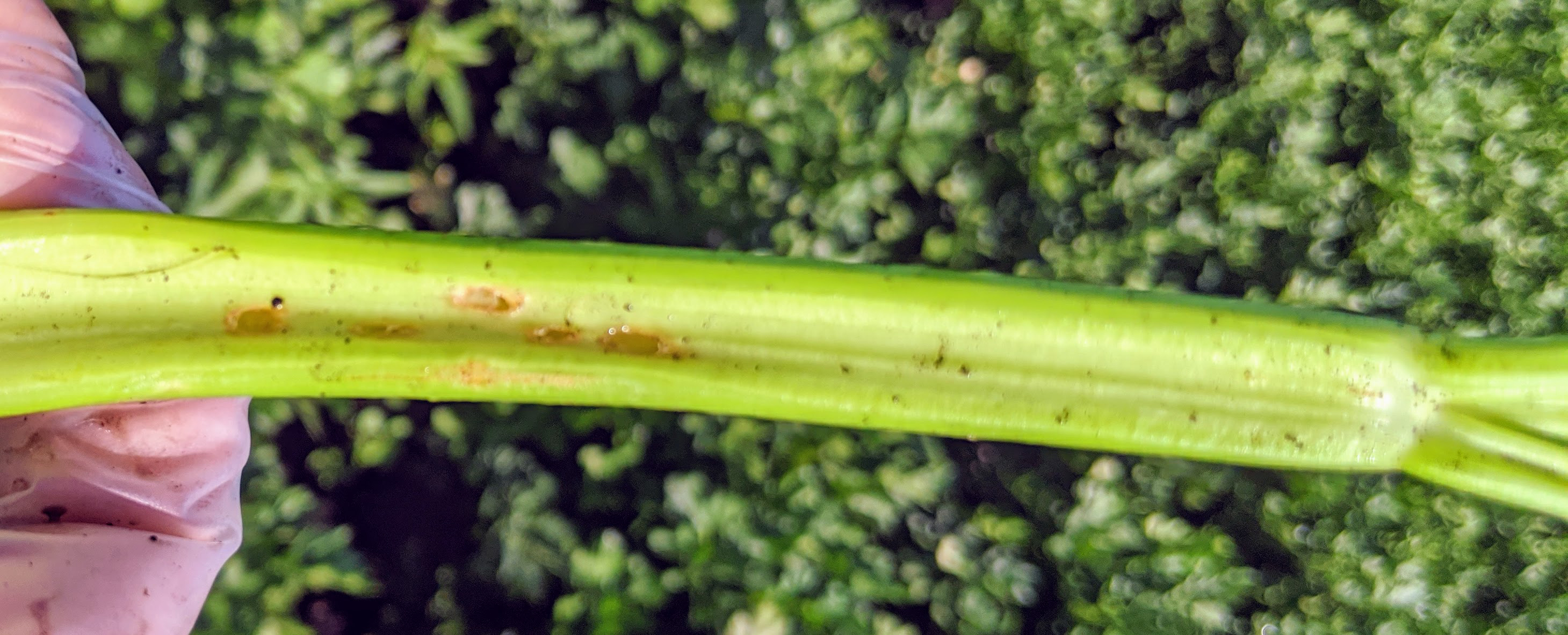West central Michigan vegetable update – Aug. 5, 2020
It’s go time for foliar disease management in many of our vegetables, and insects are still out and about.

Weather
Our cool air is courtesy of a trough in the Jetstream. A ridge is returning and will bring along warmer weather towards the weekend. We will see mostly sunny skies through tomorrow, with highs in the low to mid-70s and lows in the 50s. Thursday, Aug. 6, we will see highs in the mid-70s with lows in the 50s. The Friday forecast calls for highs in the uppers 70s to 80s with lows in the 50s. Temperatures will increase to the mid- to upper 80s with lows in the 60s Sunday, Aug. 9, through early next week.
The next chance for rain will come late in the day Saturday through Sunday. A frontal system may stall out, bringing daily chances through Tuesday. Precipitation for the next week is forecast to total 0.5 inch or less, most of which is expected to fall Saturday into Sunday. Some areas along the lakeshore are forecast to see more than this. The medium range forecast calls for above-normal temperatures with near-normal precipitation for Aug. 12-18.
Crop updates
Asparagus fern had purple spot lesions on scattered cladophylls in two fields I visited this week. Rust was visible on the edge of one field. If you haven’t recently applied tebuconazole, include it in your next cover if (A) rust is detected in your field or (B) your field had rust issues last year. Recent rains have stimulated a new flush of fern.
Carrot growers have been focused on fungicide application. Growers could include the following products in their rotation for prevention of foliar blights (Photo 1):
- Chlorothalonil (FRAC M5)
- Cabrio or Quadris (FRAC 11) plus chlorothalonil (FRAC M5)
- Luna Tranquility (FRAC 7/9) or Merivon (FRAC 7/11)
Michigan State University plant pathologist Mary Hausbeck’s work has shown that strobilurin fungicides (FRAC 11) are still helpful, though not as effective as the FRAC 7 products. Chlorothalonil should be tank-mixed with them. Generics of Quadris (e.g., A-Frame) are available and affordable. Other products are pre-mixes, so chlorothalonil does not need to be added.
Hausbeck shared some advice on crafting a good program. First, consider incorporating the highly effective products (Merivon or Luna Tranquility) earlier in your spray program, don’t wait until fall. This is important both for resistance management and crop health. Why is this? Waiting to use Luna or Merivon until the end of the season will allow pathogen levels to build in the field. Remember that resistance is like a game of chance. Think of an imaginary card game where the person who gets three Queens wins it all. Now imagine you can play this game with only a three-card hand or a 10-card hand. Someone will be more likely to take the pot if you play with a 10-card hand—the odds of drawing three Queens are better with more cards. It’s kind of the same with resistance. Allowing the pathogen population to build gives it more cards to play, and more chances for the right genes to be dealt and confer resistance to a percentage of the population.
The other consideration is that July/August typically sees the warmest overnight temperatures, with temperatures cooling after Labor Day. This means that this time period is typically most favorable for foliar disease. During these two months, TomCast meters can guide you. When you see days with 3-4 DSVs, it indicates a highly effective product should be considered. One last thought: Hausbeck’s past work showed that allowing a small amount of disease to develop early in the season can lead to issues later. So, a good control program early means overall less disease pressure and healthier tops as we move towards harvest.
Celery scouts have reported aphid colonies from multiple West Michigan farms in some fields but not others. Keep an eye out for distorted foliage with aphids on field edges (Photo 2). This is the normal time for aphids to appear. Movento (three-day preharvest interval) with a penetrating surfactant is helpful for control.

Tarnished plant bug has caused more issues this year than is normal. One field I visited had damage present (Photo 3), but no plant bugs were captured in sweeps, so damage is likely older. Worried about worms in plantings where harvest is approaching or ongoing? Baythroid has a short (zero-day preharvest interval) and carries caterpillars in its label. Mustang Maxx is affordable and has a one-day preharvest interval. Lannate and Brigade have seven-day preharvest intervals.
Mites were present on the edge of one field I visited last week, but damage was not visible. Agri-Mek (seven-day preharvest interval) had been applied.

Cole crop growers should keep an eye out for caterpillar pests. All three caterpillar species-imported cabbage worm, diamondback moth and cabbage looper-were present in southeast Michigan this week.
Cucurbit downy mildew has now been confirmed in 13 counties, including Allegan and Muskegon counties. Hausbeck recommends that all cucumber, pickle and melon growers be on a rotation of Orondis Opti, Ranman and Zampro on a seven-day schedule. Chlorothalonil should be tank-mixed with both Ranman and Zampro, it is pre-mixed with Orondis Opti. As of last week, only clade 2 had been detected. This clade of downy mildew infects melons and cucumbers, but not squash. Clade 1, which infects squash, had not been detected. Your one-stop shop for all things downy mildew is here.
Phytophthora capsici may be causing issues after recent rains. For zucchini, products with a zero-day preharvest interval that could be rotated on a seven-day schedule to protect fruit include:
- Orondis Opti
- Revus
- Zampro
For winter squash, remember that protection of acorn, butternut, spaghetti and Buckskin fruit is most critical for the first 21 days after fruit set. After this, fruit develop a degree of age-related resistance. Products include:
- Best products: Ridomil Gold Bravo (where resistance is not present) or Orondis Opti.
- Revus is another good product that has performed well in winter squash trials and could be a rotational partner with Ridomil Gold Bravo or Orondis Opti.
- Presidio could also be considered as a rotational partner.
Onion growers should be aware that Stemphlium has shown an uptick in Hausbeck’s trials, so this disease is present and active. The bacterial leaf blight Pantoea agglomerans has also been detected in some locations. Hausbeck’s lab discovered that this disease is favored by hot, humid conditions. This disease can cause significant leaf blight in onion. Control of onion thrips is the most effective option for limiting the impact of leaf blight caused by this disease.
Growers at three farms I have been scouting had made their first (direct-sown onions) or second (transplants) Radiant application last week. Make sure to include a good surfactant with Radiant and avoid tank mixes with Bravo Weather Stik. What can be used if control is needed after Radiant? Work in New York onions has found two options to be helpful for finishing out the season. Lannate (seven-day preharvest interval) is one option; research at Cornell University has shown that Warrior II (14-day preharvest interval) may synergize with Lannate to improve control. Exirel (one-day preharvest interval) is another option if you have not already used Minecto Pro.
For peppers, potatoes and tomatoes, Colorado potato beetle populations seem to be high this year. Late blight has not been reported to date north of North Carolina. For tomatoes, a rotation of a strobilurin like azoxystrobin with chlorothalonil on a weekly schedule will continue to be helpful for protecting against foliar diseases. For peppers, degree days at the Hudsonville, Standale and Kent City MSU Enviroweatherh locations suggest the second flight of European corn borer will be ongoing for about the next one to two weeks. Now could be a time to consider “A-team” European corn borer products such as Coragen (one-day preharvest interval) or Orthene (seven-day preharvest interval). Coragen is highly effective and is selective (less potential impact on beneficials) compared to Orthene.
Sweet corn insect control is always a challenge. How can insect trapping and other info be combined to make decisions? We had a very informative Great Lakes Vegetable Producer’s Network last week, and I wanted to pass the information on. One factor is the abundance and stage of field corn. If there is field corn in your area that is silking, it can serve as a magnet for corn earworm. When field corn is silking, a threshold of 10 moths per night in a wire Hartstack trap justifies treatment. In contrast, if field corn is not silking, then a catch of 1 moth per night justifies treatment (your corn is the only game in town). Next, in general early silks are more attractive than older silks. So, covering fresh silks with a good product is important. A general rule of thumb is to begin treatment when 25% of the field is silking. As silks brown, intervals might be lessened, but only if trap catches aren’t high. In addition, it’s also important not to forget about other pests. European corn borer is still around in Michigan, and degree day models at the Kent City, Hart and Hudsonville Enviroweather stations suggest it is active. Western bean cutworm is active now, and later in the season Fall Armyworm can also join the crew.
What are good corn earworm materials to use? First, there is pyrethroid resistance, but experience in Ohio suggests pyrethroids are still effective when moth pressure is low. Amongst the pyrethroids, Hero (3-day PHI) has performed well in Ohio trials. When earworm pressure is very high, pyrethroids have not always performed well. Instead, under high pressure, products with chlorantraniliprole (Coragen or Beseige) and spinetoram (Radiant) are preferred. Organic growers can use spinosad (e.g., Entrust) applied directly to the silks to obtain earworm control.
Is rotation of modes of action important in Michigan? It is not critical for us for resistance management. This is because corn earworm migrates to our region from the south. Resistance we see here likely “migrates with” the moths, which are heavily selected by intensive spray programs in southern areas, where growing seasons are long and control is tough. However, it is important to stay within label guidelines, which limit applications of any one mode of action. In addition, for the reasons mentioned above, using other products beside pyrethroids will improve control under high pressure.
Insect Forecast predicts a low risk of a corn earworm migration tomorrow, Aug. 6. Otherwise, northwesterly flow has minimized the chances for migration recently.



 Print
Print Email
Email


